#especially portuguese from portugal which is so different from our portuguese
Text
me watching Turma da Mônica dubbed in Spanish, English and Japanese: omg this is SO CUTE i love the characters' voices in this language
me watching it dubbed in European Portuguese:

#PORTUGUESE PEOPLE DON'T SEND HATE PLS LOL IT'S NOT BAD IT'S JUST WEIRD#Turma da Mônica is so Brazilian that any other Portuguese dialect just sounds so weird lol#especially portuguese from portugal which is so different from our portuguese#in english it's very different like Mônica's voice is nothing like her original voice#which doesn't make me surprised bc americans change everything#but it still fits her and the rest also seems cool to listen#the spanish one sounds funny too SORRY but it's adorable the voices just fit#the japanese one was the one who most matched with the original voices omg#CASCÃO'S AND CEBOLINHA'S VOICES IN JAPANESE OMG PERFECT#i really hope this latest season gets dubbed in other countries bc it's the best season so far#I REALLY HOPE MAN IT'S JUST AMAZING#like the episodes i watched dubbed were all from my childhood so they're very old episodes#and the cartoon improved SO MUCH after years#like the 2018 season still makes me laugh whenever i watch it#but this latest season omg it HAS to be dubbed#in european portuguese too lol
7 notes
·
View notes
Text

The traditional legends of Cuca (pronounced ku·kuh) tell that she is an ugly old woman who appears in the form of a crocodile and steals disobedient children. The cuca only sleeps once every seven years, and parents sometimes use this element of the legend to scare children who don't want to sleep, saying that the cuca will get them if they don't go to bed. Although cuca comes from Portuguese coca, in Tupi (indigenous language of Brazil), Cuca means swallowing something in a single gulp.
Even in several cultures there are lullabies that refer to Cuca, in Brazil the main refrain of the lullaby is commonly known:
Nana neném Sleep, little one
Que a Cuca vem pegar The Cuca’s going to get you
Papai foi pra roça Daddy went to the fields
Mamãe foi passear Mommy went for a walk
Desce gatinho Come down, little cat
De cima do telhado From the roof
Pra ver se a criança To see if the child
Dorme um sono sossegado Is sleeping peacefully.
The legend of Cuca was popularized in Brazil by Monteiro Lobato, through his work "Sítio do Pica-Pau Amarelo", in this story she is portrayed as a humanoid alligator with blond hair and red clothes, a sorceress who torments children who live around where she lives. (This is the most striking version of how it is recognized here)
But it is believed that the Legend of Cuca has its origins in Galician-Portuguese folklore based on the creature “Coca”, which means “skull head”.
The "Coca" is a ghost or a dragon that eats disobedient children that lurks on the roofs of houses, and kidnaps them after doing some mischief.
(But it is worth pointing out that the true source of the Cuca that we know is very difficult to define, due to the miscegenation of various cultures)
Recently Netflix launched a series that is based on Brazilian folklore called "Cidade Invisivel", in the story we follow the detective Eric in the midst of investigating the death of his wife, until some mysteries begin to intrigue the character, and folklore figures like Iara , Saci-Pererê, Curupira etc, start to appear in action. And, of course, especially Cuca, who in this version is portrayed from a different perspective, being a human woman who is a kind of witch of dreams, specialist in putting people to bed/trance, being seen as a protector of all these entities of the world. the great protective mother. It welcomes these beings, who in history live on the margins, because they were expelled from their place of origin (the forest) and are lost in the middle of the city.
I remember finishing the first season, about 2/3 years ago and simply falling in love with this new version of Cuca (who in the series is played by actress Inês Negrine). And luckily, tomorrow (03/22/2023) the 2nd season of Invisible City will finally be released, exploring our folklore even more and bringing even a little more of the tales and stories of the peoples originating in Brazil!
So, I took some time to try to combine these two versions, which are so different but still valid according to research and stories that travel around Brazil (Cuca alligator is the result of legends coming from Portugal and by the representation of Monteiro Lobato, the "traditional" Cuca of original people folklore was associated with owls and moths and this was rescued in the series, as I said there is no wrong source, just a mixture of cultures!!!), so I created my "own" Cuca to celebrate the release of the season and our culture. And that's what it turned out!
I'm going to leave here some links to see the trailer for season 1 and 2 of Invisible City, in case anyone is interested. And also a link to a scene from the series that shows how the lullaby is recited around here.
trailer for the first season of invisible city with english subtitles here!
Trailer for the 2nd season of invisible city (unfortunately I couldn't find the trailer with English subtitles, but you can activate the automatic subtitles translated into English through YouTube)
Scene from the series with the lullaby here! (The audio is not the best)
#cuca#digital#moth#digitalartwork#fanatsy#folklore#illustration#mythology#witch#witchcraft#folklore fantasy#brazilian folklore#fanatasy art#folklore creatures#folklore inspired#artists on tumblr
20 notes
·
View notes
Text
Who will qualify from ESC SF1 in 2023?
Eurovision is on! Rehearsals are on! We’ve seen most of them performing at the multiple preparties and the first clips (even super shots ones) are in!
It’s time to predict who will qualify on May 9th from Semifinal 1! These are my predictions based on the reactions, comments, listens and clicks in social media, Youtube and Spotify.
Some I will get right, others I may not - that’s the risk you will take by continuing reading this.
1. Norway - Alessandra - Queen of Kings

She’s IN. No question. HUUUUUUGE viral hit by now. There was some concern about Alessandra’s vocals (MGP used autotune) when performing live but she’s on point based on the first rehearsal clip. Visually they’re loyal to National Final one but her outfit is a bit different, she’s wearing a crown look a like hair band and there’s more light now on the stage.
2. Malta - The Busker - Dance (our own party)

This is worst spot in semifinals to perform as second in Eurovision. Lots of good entries have failed because 15 other amazing songs will follow and people tend to forget. However, Malta’s lively and colourful performance does stand a chance. The song stands out with its saxophone sound. If this did go through would I be sad, definitely not but being where it is, second and between two dark songs (Norway, Serbia) I say this is OUT.
3. Serbia - Luke Black - Samo mi se spava (Само ми се спава)

One of my faves this year but I know a lot of people who’re not warming up to this Hatari II. However, their staging looks improved and Luke’s performing very confident. This kind of dark pop is exciting for many! In Eurovision it doesn’t matter how many haters you have but how many lovers, based on the interest in Spotify / Youtube I’d say this might appeal enough voters to be IN.
4. Latvia - Sudden lights - Aijā

Indieband with a strong chorus. In the national selection the staging didn’t impress me but this is one of my faves again. Lamps are there though but there’s a good energy in here which I hope will come across to the audience. This is still boarderline, this can go to either direction. But I have faith so IN.
5. Portugal - Mimicat - Ai coração

Portugal has been topping their game in preparties and even though you wouldn’t like this kind cabaree music - this is very authentic, catchy, memorable. And she can sing and perform - true pro! The stage looks a bit empty without the couch but I do have faith in Portuguese staging skills because they have nailed it during the few previous years. I still say IN.
6. Ireland - Wild Youth - We are one

Why the producers put this at 6th? If this had been an opener for this semi Wild Youth could have had a chance. However, they’re going all the way with the staging, using every inch of that stage: we have golden body, pyros, stairs - we know the guy can sing but the song is a bit generetic and forgettable. This breaks my heart but OUT.
7. Croatia - Let 3 - Mama ŠČ!

A big fan favourite. Huge interest before going in to Eurovision, they also did well in the preparties. We saw some aspects from the pics and Tik Tok clip that we saw before (same LED screen, cannons). Not my personal favourite but a lot of people love this kind of quirky performance so IN.
8. Switzerland - Remo Forrer - Watergun
One of my personal faves this year but again - a lot of people don’t agree with me though. The anti-war song was actually written two years ago which I kind of hope would push some buttons among the voters. However, Switzerland was one of those unfortunate countries last year who went to Final with Jury votes only and received 0 points from audience. This time around Semifinals have only audience voting so I’m afraid there might be payback and especially since it’s another Swiss ballad.

Staging like this can be strong but the clip didn’t convince me yet. Pretty dark and they have similar strings attached to the dancers as Finland had in UMK (why are you coping??). I love this but I say OUT.
9. Israel - Noa Kirel - Unicorn

She’s IN. This is not my favourites to be honest, just because it’s so messy genre like. Israel was a bit of mystery to everyone because they didn’t participate to any preparties and they kept all their plans as a secret. But she sounds amazing and the Tik Tok clip and the photos promise us a spectacle. The seem to have a running unicorn in the LED screen, she’s in this bright box, upside down and in the end she’s making Chanel style break dance. This will please many for sure and high chances of becoming a top5 in the final.
10. Moldova - Pasha Parfeni - Soarele și luna

This is one of the most ethnic entries this year and Pasha Parfeni is no stranger to Eurovision as he represented Moldova also back in 2012. The song is memorable, it does stand out and the live performance even just from the pictures doesn’t disappoint. Moldova is a master of creating memorable performances even with a smaller budget and there’s no way that this didn’t go through. So IN.
11. Sweden - Loreen - Tattoo

Do I need to say this? IN. The LED sandwich so called what they used in Sweden was a lot bigger(16 m² ) but I don’t think the current size (6,25 m² ) will cause actual problems because the camera work will make it look larger. This is copy paste from Melodiefestivalen so pretty epic. A lot of people do complain however that Loreen is not bringing anything new to ESC as this does remind her victorious song Euphoria from decade ago. However, potential winning song for sure!
12. Azerbaijan - TuralTuranX - Tell Me More

One of the indie entries we have this year. I quite like it but... this is not a crowd pleaser unfortunately and in Eurovision you kind of have to be. This is such a good feel song but no. Stating isn’t doing much either, they’re standing on the platform of spaped by the heart playing their quitars. Unless there is something major happening what wasn’t revealed in the Tik Tok clips. I’m sorry, OUT.
13. Czechia - Vesna - My Sister's Crown

There’s so much love for this entry but at the same time there’s talk that this might be the shock non-qualifier. They didn’t perform as well and confidently as people were expecting them to during the preparties. However, in their live rehearsals we see them wearing rose coloured outfits, they have long braids - there’s a message of we’re not your dolls combined with some doll movements so very strong female empowerment thing going on. This can get too messy but hard to say from the Tik Tok clip itself. I still belive this would be IN.
14. Netherlands - Mia Nicolai & Dion Cooper - Burning Daylight

Another sleepy ballad. I don’t hate it. And to be honest this has the strongest ballad staging I’ve seen so far. Mia and Dion are standing on this moving platform and walking towards, around, from each other. This can be a moment, beautiful one. Their voices go nicely together. BUT this comes after a strong Czechia and before Finland. I don’t see this year being very kind to the ballads, people are clearly having more reactions (clicks, listens etc) towards the quirky songs of ESC 2023. I say OUT.
15. Finland - Käärijä - Cha Cha Cha

A big fan favourite when going in for the rehearsals. Many didn’t expect Käärijä’s team to change the stating at all actually because it was pretty damn good already at the UMK. However, they have upgraded it. They have this big wooden box on the stage, according to photos and the Tik Tok clip he’s in it at some point and also the dancers where they emerge at one point. The silhouette is awesome! Great add and super powerful! There’s pyro at the end also, colours of the rainbow - the human snake has movement. This is so good! If Finland doesn’t win the ESC alltogether I do belive this will make the televotes to explode at the semi for sure! IN!
What do you think of the songs in Semifinal 1 and who do you think will qualify? Talk to me in the comments below!
#eurovision#Eurovison Song Contest#eurovisionsongcontest#euroviisut#eurovision2023#united by music#semifinal1#liverpool#eurovision23
11 notes
·
View notes
Note
Fun asks ahoy ✨
1, 4, 6, 8, 9, 11:D
Thank you for the asks. I will do like you and put it under read more since this definitely will end up being too long.
what are 3 things you’d say shaped you into who you are?
Preschool: There were so many creative activities in preschool and because it made me try so many things it made me discover my love for art and writing, especially. When I started the first year of school I got a library card which also made me discover a love for reading. Attending preschool also gave me the tools needed to tolerate others and learn to cooperate even with someone I don't like. It also gave me a little trauma, but that is not something for the public...
Cosplay Events: My teenage years were definitely the most awful years of my life until I was 16. At that age things got a little better because I finally met someone that made me aware that other people that liked anime and manga existed and there were even events where they dressed up as the characters and made art about it and everything. It seems odd nowadays because it seems to be a popular thing now, but there were very few events in my country and most of them were free at the time. It was just a way for all the nerds to get together and have fun and that's what I did too. People think they want to be unique, but I don't think anyone that was actually outside of the norm at one point wishes for that. I was lucky enough to have had one friend that shared my tastes since primary school, but being considered weird was still extremelly lonely. Not that I wished to be like everyone else around me, but I wanted to be liked. Living in a small town full of people with retrogade ideas while growing up was hell. Being able to go to the capital city often and making friends saved me from growing up bitter. I was so happy to find out that people like me existed. They just happened to be in a different city. Another thing we all seemed to have in common was the bullying we suffered in our schools so going to cosplay events and meetups was our safe space. At this time I was also on DeviantArt participating in manga events and meeting other artists. Knowing that I wasn't alone in my weirdness gave me hope for the future.
My first trip outside my country: In your answer you said you wanted the perspective of someone that never moved places so I can tell you that it made me very careful and fearful of many things. I am not the kind to take many risks (unless I am on a weird day because I swear that sometimes I am possessed by something that would rather die than be bored) and I need some sense of security and that can be provided by a place or a person. On my first trip outside my country I was so nervous because I had never gotten into an airplane and I went alone. I went to stay with a friend that moved to London and we were supposed to hang out all the time when I got there. However, I spent most of my visit alone since my friend didn't got the vacation for those days. I would like to thank my best friend google maps and the amazing transportation of London. Portugal wishes it had transports that efficient. I had to get by on my own and even though I felt lonely at times I was still happy to explore a new place and I even talked briefly with a few strangers. I still got to hang out with my friend when she got out of work at the end of every day. This made me a little more independent and also gave me a love for travel even though I found London a bit disappointing (my expectations were too high). It also showed me that when left alone I didn't know how to feed myself. Now, I plan those things much better because let me tell you that my stomach on that trip wasn't happy about the crap I was eating at lunch everyday.
4. what’s an inside joke you have with your family or friends?
I am sure we have some, but I remember nothing at the moment, sorry. It's usually some portuguese meme that we parrot around.
6. what’s the best and worst part of being online/a creator?
As a creator that seldom creates, this is really hard to answer. I guess the best part is finding other creators that love something as much as I do and also to find people that appreciate what I do. The worst part would be negative comments and harassment, but I don't usually get those so... oh, having no reaction to what I post can hurt sometimes too, but I create mostly for myself and I am aware that the things I love aren't that popular in the great scheme of things to begin with.
8. any reacquiring dreams?
No. I seldom dream. When I remember my dreams they are usually weird and nightmarish like the fans on the floor that were cutting everyone's legs. I think I dreamed that I was falling from the sky at least twice in my entire life though because I remember once actually falling from the bed and another time when I woke up breathing heavily and grabing the corners of my bed.
9. tell a story about your childhood
One of the childhood moments I remeber the best is when I went to the beach with my parents and some of my family when I was really young. I don't remember my exact age, but I wasn't in school yet so probably 4 or something. One of my older cousins told me to go fetch water so we could build a sand castle and sent me on my way with my little bucket and nothing else because it was supposed to be a short trip. Turns out my sense of orientation has sucked since birth so I got to the water and filled my bucket, but somehow failed to find the way back to the towels where everyone was. I remember walking for what it felt like hours without a hat or shoes and at one point the sand started to burn because it does that around midday, when it's too hot in the summer. I remember that at one point I just splashed the water from my little bucket on my feet because I was in pain, but I never stopped walking even though I was crying and who knows where I was going. A nice couple found me and I remember the man held me in his arms and that's when my feet felt some sort of relief. Then they went looking for my parents and they found them eventually since my parents and the rest of my family were also looking for me. My mom has at least one more story of me getting lost as a kid, but this is the one I remember and the one I was lost for a long time.
11. what do you consider to be romance?
Damn, I just posted a quote from the Buried Giant about something similar hahaha Romantic love is very hard for me to define. When I was a teenager I thought I had it figured out because that was what most people seem to consider romantic love. The first person I ever liked wasn't only physically attractive, but was also my friend. That is what I would consider the whole package haha I would talk to them everyday and wonder what they were doing all the time and I would feel jealous if they liked someone or got with someone. Looking back it looks more like an obsession than love. I once had a friend that was in love with me and told me I had never been in love. It could be the butthurt of rejection talking, but maybe he was right. I honestly have no idea if I have ever been in love because I can't really define it. Right now I am in a weird situation. I am not really dating, but I have something (let's call it that). I don't feel jealous of other people that hang out with this person nor do I feel the need to talk to them or see them all the time, but it still feels nice when we are together.
Honestly, there are a billion definitions of romance and different people would provide different answers. All of this to say that I have no idea of what my own definition is and maybe I will never know. I decided to let things happen since I have bigger troubles than romance at the moment. That is another thing. What people usually call romance is also associated to stressful things to me. It's probably because of the examples I have had growing up. People are always afraid of being cheated on or jealous if their partner hangs out with others and such. Honestly, it looks way too troublesome for me to deal with so I do not want it to be like that and I also want to mantain some of my freedom.
#fun asks#andy answers#damn this was too long and I am not sure I was coherent#I am too lazy to reread so I apologize for that#I talk and talk and talk and say nothing meaningful haha
2 notes
·
View notes
Text
Wednesday, November 8 - Funchal, Madiera










We arrived here just after dawn, when the sun started hitting the tops of the hills. The islands of Madiera are volcanic and quite vertical, as we remembered from our first trip here. That time we had taken a bus up above the main city of Funchal and hiked down a very steep hill until it leveled off several hundred meters above town, and we walked along some levadas.
Levadas are the traditional way of getting the water from the wetter north side of the island to the drier south side, and are an elaborate system of small canals (300 meters worth!) that drop only a couple of inches over a kilometer. Because of the steepness of the island, agriculture has also always been terraced. We had signed up for a "levadas walk" this morning, and were driven up to over 800 meters of elevation on the eastern part of the island, on very steep roads. The whole walk was only about 4 miles, but we stopped partway for a local drink of rum and fruit juices which reminded me of a pisco sour. Because the levadas are almost level, it was a nice shady very easy walk with lots of spectacular flowers, mostly in the countryside, but sometimes near small houses or the occasional overlook. The climate here allows almost every kind of plant to flourish, especially out of the normal seasons.
Bicycles seemed to be a theme for decorative fencing, as we kept seeing them along the way. Probably better for that than being in a landfill - especially on an island. Madiera is utterly charming with its lovely climate, sun-drenched, red-roofed houses almost all with a view of the sea. Of course, it has been discovered and property values here have soared in recent years, as many outsiders have discovered its charm.
Madiera has no history of habitation until it was claimed by Portugal in 1419, when Portuguese explorers in the service of Prince Henry the Navigator arrived. It was settled starting the next year, mostly by farmers and fishermen. Sugar cane grows well here, and it was the major crop until the 17th century, when other areas outcompeted Madiera, and about this time, wine became the major export. I had always thought of Madiera wine as sweet, but it comes in five categories from dry to sweet dessert wine. Today, of course, tourism is also a major industry.
After our little hike we still had time to drop our packs back at the ship and walk around the capital of Funchal. We decided to go back to the central market, which was extremely crowded on our last visit, and which was much less so today. Lots of lovely produce for sale, as well as flowers and tourist goods - I loved the sign which specifies which items are available, and it seems interesting that they call out shredded cabbage separate from fruits and vegetables. Maybe it's different in Portuguese.
We walked some different streets than before and came across a photographic exhibition in a wonderfully tiled atrium of a building. The historic photos showed celebrities and activities from the past, but when I turned around to look at the fountain in the center of the atrium, I saw it was filled with turtles, including this pair.
Like most Portuguese cities, the sidewalks were patterned with black and white tiles or pebbles, and the Se (cathedral) is fairly modest, although the ceiling inside is made from elaborately carved wood. We could have spent more time here (actually it would be lovely to stay here for several weeks, at least), as it is extremely easy to get around on buses, and there is lots to see and miles of trails to explore. Plus, produce and wine are plentiful, good and inexpensive, and at night, the cruise ships leave.
Now that we have left Madiera behind, we have six days at sea before reaching Sint Maarten, and four more time changes. The weather is predicted to be great, and gradually getting warmer as we move further south and west. The days of wearing a jacket on deck are passed, and it's time to bring out the shorts!
0 notes
Text
Ola, it's me again, Crista! So, for today's blog, we are going to talk about how the fiesta in Borongan was celebrated. But before that, let's get to know its history and origin.
Padul-Ong Festival in Borongan City, Eastern Samar.


Padul-ong Festival is a religious festival in Borongan City in the province of Eastern Samar, Philippines held every September 8th. A weeks-long festival, it is conducted in honor of Nuestra Señora dela Natividad, the patroness of the city. It also coincides with Borongan City Native Pig Lechon Festival.

History of Padul-ong Festival.
Padul-ong Festival comes from the word padul-ong, which in the Waray language means deliver or transport. As a fiesta, it recalls the miraculous journey of how Nuestra Señora dela Natividad (Nativity of the Blessed Virgin Mary) became the patroness of Borongan during the Spanish rule.
According to the tale, a woman with a box as luggage was given accommodation in a Portuguese ship heading towards the Philippine archipelago. Sadly, she died in the sea voyage. When the ship arrived in the Philippines, it docked in Punta Maria of the island of Samar. The box that the woman brought was opened and revealed the image of the Blessed Virgin, which was installed in Punta Maria.
Later, stories began to spread that a mysterious lady was taking a bath in Hamorawan spring. She disappeared as soon as people would see her, but she left an unmistakable scent behind. The waters of the spring were reported to have become miraculous and had healing powers. Townsfolk believed that the image of the Lady was performing miracles and it was then decided that the image be brought to Borongan.
According to expert Lope Coles Robredillo, the belief that the spring of Hamorawan has curative potential may date back before the coming of the Spaniards. Furthermore, the story that illustrates how the installation of the image of Mary from Portugal in Borongan Cathedral, the Cathedral Parish of the Nativity of Our Lady, came to be could be an accretion of different origin stories.
During these festivities, I am with my friend, Lau. He accompanied me to that event since it was my first time attending it.

As a first-timer, I am amazed at the ambiance of every place that we are passing by. The creativity of the colorful decorations really caught my attention. I can vividly see the beauty of each flower in the streets in its different colors, how banderitas are laying up there on each street, the loud music in every corner, and the lights that make the view more appealing.

I appreciate the people who made it just to make it extra wonderful. I remembered I was asking too many questions because I was too curious about it and how it would go. The excitement I cannot control is visible on my face. There are also many people watching and busy doing their own stuff while waiting for the event to start.
It's kind of tiring, especially since there's a sun and it’s too hot, but I can say it's all worth it. The people who perform are quite amazing in how they represent themselves as they follow the steps in each beat of the music. Their clothes, costumes, and attire, and how they are presentable to the audience, make an impact.
I definitely had fun, and I will consider it one of the most remarkable days that I will never forget. Again, this is Crista, and have a nice day ahead!
Sources:
https://www.festivalscape.com/philippines/eastern-samar/padul-ong-festival/
https://www.hellotravel.com/events/padul-ong-festival
https://allaboutfiesta.wordpress.com/2016/09/05/padul-ong-festival-of-borongan-eastern-samar-september-6-8/
0 notes
Text
just a little vent
TW: suicide
During my last year of highschool (which just ended), I met a boy, let's call him John, a year younger than me during badminton practice. This was mid-October. We bonded over the fact that none of us was remotely good at it.
I'm from Portugal, John is Brazilian (both countries speak the same language, just different accents). After practice, I heard him tell a friend about speaking Polish. I'm saying this because I remember being jealous of this guy. From basically an hour of interacting with him, I knew that Portugal was, at least, the third country he had lived in. He knew a third language. I always "resented" the fact that I only spoke Portuguese and English. I already admired him.
When I got home, I had a follow request on insta. It was John. I followed back and took a look at his story. And I've never been the same after that.
He had reposted a story of someone from another school who had been at the release of white balloons into the sky. I don't know if this is universal, but here, that's mostly a homage to someone who died. The next story was just a plain text of him thanking everyone who had reached out to him because of his brother.
John's brother had died, and I never would have guessed it. If one of my sisters had died, I wouldn't even be able to go to school. Wait, the story's not over.
Curiosity killed the cat, isn't that what they say? Well, that day, I learned a thing or two about misplaced curiosity.
Since my younger sister is much more social than me, I asked her if she had heard of anyone in that specific school that had died. Then I showed her the white balloons. She told me: "yeah, I heard of that. A guy from there killed himself last week."
Let me tell you, I felt sick. I feel sick just recalling the memories and thinking about this whole situation.
Then she asked me how had I heard of it. And I said: "I think I met his brother today."
Of course, this is all terrible, especially because I've known John for almost a year now and every time I see him, I can see that no smile of his is real. After I learned about what happened, that was all I could see when I looked at him.
As someone who has dealt with suicidality for years now, this whole thing shook me. John and his brother were all I could think about. I would live every possible scenario in my mind of how that kid could've killed himself and I would vomit after that, disgusted with myself. But it was a cycle.
What did I do to deal with all of that, you might ask? I wrote poems. I never talked to anyone about the extent of how I related and how affected this story left me. Much less to John. I don't think he knows that I know. So I had to write about it. I wrote about how, in a parallel universe, I would've been the one to die and John's brother would be the one to grieve and write about a guy he never even met. I wrote about John's grief, what I could see of it.
It wasn't much, but I started picking up on things. John's brother died a couple of months before they turned 16. Yeah, they were twins. John didn't throw a birthday party. Things like that.
After writing, I started feeling better about this. Then my birthday came, and I was thrown back to square one. I met up with my cousins that day. I was already feeling shitty because of an unrelated issue, but it eventually got worse in every way.
My father joined us for part of the conversation and, somehow, it led to my old man explaning how water basically turns to stone if you hit it hard/fast enough. One of my cousins suddenly remembered something.
He had heard some people in his school talk about a guy, who was about our age, who had jumped off one of the bridges over my city's river. Apparently, at the funeral, the family had let the casket open. My cousin said: "I wasn't there, but someone who was told me that every inch of skin was bruised."
This rang a bell, but I didn't want to presume. I asked my cousin if he knew which school had the boy attended and when had it happened. It all matched. Now, not only was I haunted by the knowledge that I knew this guy's brother, was friends with him, had exchanged favorite Taylor Swift songs with him, I also knew exactly how he had died.
Bonus: do you think I ever looked at the river the same way? Not a chance. It used to be so much fun, now I can only pitcure someone jumping and falling off the bridge.
Anyway, that was the vent. You can ask questions, I'll answer if I can. Thank you for reading. No tags because this is not a call for attention.
0 notes
Text
Why Ethical Fashion Doesn’t Need to be Boring (In the Words of a Shopping Addict): Lookbook no.14
Hi to anyone reading,
Arghhhh.
I never know how to start posts when I literally just uploaded the other week because I tend to follow the very formulaic approach of summarising what I’ve missed due to sporadic posting…I mean, don’t get me wrong, I’m still posting sporadically, it just so happens I’ve had more content to get up recently-sometimes lightning strikes twice, ya know, and I have a brief, if chemically fuelled, reprieve from the permanent state of exhaustion. It’s not like there isn’t stuff to talk about- the last month has seen a horrific murder and public outcry in response. There are a lot of important conversations going on about women’s safety and misogynistic violence that I really cannot do justice to in a paragraph and feelings that have been brewing for a long time that I can’t articulate yet and will not attempt to offhandedly do so in this post. Right now I just wanna say that I stand in solidarity with all those with histories of experiencing violence at the hands of men, those who aren’t here with us anymore as a result of that violence such as Sarah Everard, and those marginalised women whose stories don’t make national news. It’s very telling the way Sarah’s vigil was responded to by the same police force that have allowed mostly male anti-mask protests to go ahead with protestors unscathed, and solidarity with the women who were treated with such an unjustifiable amount of force at the vigil too.
That being said, women’s rights are something I wanted to talk about in this post, with regards to the way it ties into ethical fashion. None of us are perfect and it’s easy living in a first world country to detach yourself from the issues stemming from fast fashion, especially when you don’t have the time or money yourself to be selective about where you buy from. Don’t get me wrong, I do treat myself to some new clothes from fast fashion companies like ASOS and Urban Outfitters a few times a year so this is NOT coming from a place of preaching, but I have drastically reduced that to buying about 90% of my new clothes either second hand from Depop or charity shops or clothing stores that are upfront about their outsourcing practices. I love putting outfits together and updating my wardrobe and I don’t want to abandon that as a medium of self-expression because it does bring me joy, but to continue to update my wardrobe with the frequency I do by buying from fast fashion retailers on such a regular basis I accepted was going against the things I care about; around 80% of textile workers on poverty wages in developing countries are girls and women (opensocietyfoundations.org), and whilst fast fashion companies in the West continue to outsource manufacturing to said countries to cut costs and there is little regulation enforcing employers to pay women the same amount as men or even adhere to a minimum wage, they will continue to be forced into these roles where they are subjected to horrific working conditions, impossible production targets and frequent abuse (according to an article published in the Guardian in June 2018, 540 incidences of abuse, often of a sexual nature, were reported by women working in factories supplying the retailers GAP and H&M when they were interviewed on the subject). There is no denying that the fast fashion industry depends on and perpetuates the subjugation of women and systematically prevents them from making steps towards gender equality in their countries, be it through greater financial independence or the freedom to pursue higher education; the popular current practice by western fast fashion companies of outsourcing manufacturing to factories unhindered by workers rights and gender equality laws by association condones the sexual and physical violence that occurs as a means of punishment for not meeting targets, the exploitative pay which affords women little independence from husbands and families dominated by patriarchal values, and the long, exhausting hours which women have little choice but to take in order to avoid their contracts being terminated and to put food on the table. No, one individual completely abandoning fast fashion isn’t going to put an end to these unethical practices but if all of us make a conscious effort to reduce our consumption at least a little and make it clear why we’re doing so, we put greater pressure on fast fashion companies to act in a more responsible way. There isn’t going to be any kind of miraculous change of heart, so to force them to change we have to hit the industry and the people at the top who benefit from such practices where it really hurts: their profit.
SO, for this post I thought I would highlight some of my favourite more ethical online clothing companies to buy from; the more popular these more socially responsible brands become, the more apparent it becomes to fast fashion companies relying on an exploitative business model that how they treat their workers is of growing importance to consumers. It’s all very well and good Missguided and PLT talking about empowering women and making “girl boss” slogan tees but we need to make it clear that we’re aware of the hollowness of the gesture, and that we want less hypocritical talk and more action to actually enhance the lives of the women that work for them, not just the ones they show in their flashy offices on TV. I’ve included my favourite Depop shops too, because if you can shop second hand, that’s even better; though I like to treat myself to new clothes now and again, I’m aware that the impact the manufacturing process in general, whether or not the company acts in an ethical way with regards to their employment practices, has on the environment is more often than not detrimental. Depop has really been my saving grace this past year-if you know what you’re looking for and have the time and patience, you can find so many gems, and at this point the balance of my wardrobe is tipped firmly in the favour of the reuse and recycle approach to shopping. In the vein of reusing fashion, I thought I’d also include a mini lookbook for a cardigan I got from one of my favourite online retailers, The Ragged Priest, just as a reminder that 1). The best way to be sustainable is to rewear and 2). That with tweaks, one piece alone can give you multiple completely different outfits. Like honestly, outfit repeating doesn’t have to be a literal repeat. Sometimes it’s worth spending a little bit extra on something that looks good with everything, and making that investment into your ability to fool people that you’ve got your shit together by wearing something cool as fuck.
Quickly before I get into it, I’m aware that some ethical companies are a bit out of the average consumer’s price range, and so I wanted to sort them into price point categories which will work as follows:
£= most of their stock is £40 & under
££= most of their stock is between £40-£100
£££= most of their stock costs upwards of £100
Now, in no particular order (and starting with online retailers before moving onto Depop shops), here’s the list!
1. THE RAGGED PRIEST
PRICE POINT: ££

Using recycled fabric to construct their pieces where possible and releasing clothing in small drops designed to sell out rather than following the typical fast fashion model of outsourcing the production of vast amounts of clothing overseas, the Ragged Priest is my absolute favourite clothing brand out there. It’s *semi* affordable and because they are all about those bold, in your face, your-grandma-will-probs-think-it’s-ugly kinda pieces, just one can do SO much for your wardrobe.

I recently bought this cardigan from their The Simple Life drop and had so many outfit ideas for it that I thought I’d put a few of them together for this post just as an example of how you can take the same piece over and over again and still make it interesting, even when you don’t feel like straying too far from your personal style preferences. While we’re at it, I also wanted to use this mini lookbook to point out how fucking great Depop is! Literally everything in these outfits is from there apart from the shoes and the jewellery, the leather blazer on the right I bought a few years ago and then the top and skirt in the outfit from the far left which are both from Ebay. The shoes with that outfit are from Koi Vegan footwear-I didn’t include them in this list because I wanted to keep it consistent and focus on ethical clothing companies rather than retailers that focus on one specific thing such as shoes or jewellery, but they are my favourite place to buy shoes from and focus closely on ethical production too so definitely recommend.
2. MINGA LONDON
PRICE POINT: ££

Towards the lower end of the ££ price point, Minga is probably the closest you’re gonna get to an ethical version of the Dolls Kill Deliah’s range. Their focus on being a socially responsible business is a huge part of their ethos and their pieces are put together in Portugal, where they're based, by a small in-house team; the majority of their fabric is sourced from local Portuguese businesses and even more amazingly, they recycle the fabric of the pieces they don’t sell in new designs. They are just a generally amazing company and I wish more people knew about them because their pieces are fucking adorable and wouldn’t be out of place (or overpriced) in your local UO.
3. ELSIE & FRED
PRICE POINT: £

A small, black owned business set up by 3 siblings from Coventry, Elsie & Fred have earned themselves a reputation as a staple provider of the festival season wardrobe. Being an independently owned business, they have strict standards that their manufacturers must adhere to and a close working relationship with the owners of the two factories who oversee production in Guangzhou, China, to ensure fair wages and a safe working environment. On the environmental side of things, Elsie and Fred are working to incorporate recycled fabric into their designs as much as possible and have this year introduced compostable mailing bags.
4. HOUSE OF SUNNY
PRICE POINT: £££

Follow enough British instagram fashion influencers and you are bound to have heard of House of Sunny in 2020-snagging what is probably my all time favourite coat from there in 2019 before all the hype is a humble brag I will allow myself on the basis that I haven’t been able to afford anything since, lol. Along with kooky, one of a kind designs, being decidedly anti-fast fashion is a huge part of their branding; HoS only drop 2 collections of limited stock a year, thoroughly screen suppliers and on their website you can find a tonne of information on how they’re working to offset their environmental impact too. If you can treat yourself to a piece from there at any point, the quality of the garments truly make the price point worth it.
5. JADED LONDON
PRICE POINT: ££

Similarly to The Ragged Priest and House of Sunny, Jaded London go the route of dropping limited collections on a less frequent basis intending to sell out (particularly popular pieces are occasionally restocked) rather than needlessly manufacturing vast quantities of garments to flog for whatever they can get and cutting corners with fair employment practices to offset any losses. By employing independent staff in the manufacturing plants with which they liaise to ensure fair, dignified working conditions and also by working closely with charities such as the Trussel Trust and Stand Up to Racism, Jaded London demonstrates a level of commitment to corporate responsibility that set them apart from a lot of similar online retailers. They are at the top of their game when it comes to daring and experimental yet wearable pieces and so it’s cool that they recognise the need to conduct their business in a considerate way too.
6. THE HIPPIE SHAKE
PRICE POINT: ££

Owned by UK based bohemian queen Naomi Hession, the Hippie Shake is not only a great small independent business to support but is also the definition of slow fashion. With a limited number of opulent 70s style pieces, I have always wanted to purchase something from here. I’ve yet to do so but I’m gonna make it my mission eventually.
7. VINTAGE HEARTS
PRICE POINT: £

An affordable, gorgeous array of quirky handpicked vintage pieces that would probably take you forever to find in a charity shop or that you’d be charged a small fortune for if you found it in a high street second hand store, Vintage Hearts is where you should go if you want a timeless statement piece that may have otherwise ended up in a landfill. The added benefit of vintage clothing is that it is, by its nature, great for the environment, but you can also look fab and groovy as fuck as you do your bit for the planet<3
8. WE ARE COW
PRICE POINT: £

Offering both original vintage pieces and reworked pieces using recycled fabrics, We Are Cow has both basic branded second hand items but also handmade streetwear style original designs all for a fair price. You can tell that it’s all high quality stuff consistent with their modern, functional aesthetic and it’s clear that the team behind the shop has a real vision in mind when they’re designing.
9. OUT OF THE ORDINARY CLOTHING
PRICE POINT: £

In the words of Corrie Davis, founder of OOTO "I start with the belief that fashion will be always be worn differently by the individual that wears it. Every collection from Out of the Ordinary is different to the last but undeniably Out of the Ordinary. I champion flamboyancy and embrace the cultures I've experienced around the world, merging the two and creating popular style trends in exciting textiles, prints and techniques to bring to you something a little Out of the Ordinary." That pretty much sums up the vibrancy, vivacity and bold elegance of the brand’s aesthetic perfectly, which is reflected by Davis’ commitment to ethical manufacturing based on relationships forged between the founders and family artisans and the sourcing of fabrics from textile markets around the world. Everything you need for a boujie summer holiday in the Mediterranean-when leaving the country is finally allowed again, lol, EVERYBODY GET YOUR FUCKING VACCINE-is here.
10. WILD THING
PRICE POINT: ranges from £-£££ depending on the brand

Probs the closest thing you’ll get to an ethical ASOS, Wild Thing brings together a host of sustainable and independent clothing brands and puts them all in one place to present to us all a collection of the sickest festival style fashion out there. Whilst it’s super cool that this already exists and a slice of humble pie for myself to remind me that I am not in fact the revolutionary marketing genius I thought I was, I’m bummed to know that my idea of said ethical ASOS style website is already out there. Fingers crossed for the next grand money making scheme that comes to mind that I can use to distribute some wealth (yeah, there probably won’t be any because very few original thoughts enter my head, clearly, tehe) xoxo
11. SHOPFLUFFY
PRICE POINT: ££

I know it’s 2021 and we all kind hate the idea of girl boss feminism and the connotations of privilege and exploitation that come with it but can we bring it back when we’re talking about women who embody what it was actually all supposed to be about? Because the owner of ShopFluffy, @lulutrixabelle embodies everything good about the term. Somebody who genuinely does (cue Ramona singer voice here) empower other women through her celebration of powerful female friendship and free spirited sense of personal style that should inspire every one of us to wear whatever the fuck we want (clashing patterns and over-accessorising be damned), Lulu handmakes all the designs on her site and very much places an emphasis on slow fashion by releasing only a few collections a year which you can clearly tell a lot of painstaking effort and talent went into. ShopFluffy is on the pricier side but the adorable crocheted coords LuLu specialises in, reminiscent of carefree childhood days and picnics in meadows picturesque enough to be the backdrop of a Jacquemus runway presentation, are a bold and beautiful expression of playful femininity worthy of departing with a bit more than you’d usually spend. After all, if you are gonna spend that money on a piece of clothing, supporting an ethical, independent woman owned business clearly built on carefully honed skill, passion and authenticity is the way to go.
12. SHOPEASYTIGER
PRICE POINT: ££

It feels correct to follow up the ShopFluffy mention with ShopEasyTiger given the friendship between the former’s owner with Tigerlilly Winfield (is that not the most wonderfully storybook character sounding name of all time?), owner of Easy Tiger. Up there with my most revered style icons, Tigerlilly’s designs are as flamboyant and glamorous and daring and dramatic as her own personal style, and again, they are ethically made! If you want to get that psychedelic rock n’roll groupie that’s actually way cooler than the band itself kinda energy too, her shop is the place to start.
13. HOTTTRAMP
PRICE POINT: ££

Founded by the incredibly hot Belle_hott_tramp on Instagram, HottTramp is a collection of both handmade pieces and carefully selected vintage finds that blur the lines between 90s Courtney Love style grunge and 70s summer of love hippy that make me want to start my own all girl rock band and hire a camper van to paint black and road trip through the American desert. Given my complete lack of hand eye coordination, I’ll most likely never have the instrumental skills to do that but I never said it was a realistic fantasy, okay?
14. LAZY OAF
PRICE POINT: ££

Is it just me that always thought Lazy Oaf was within the same kind of price range as The Ragged Priest? Because it’s a lottt more expensive than I thought. That being said, if you’re going for a playful, toned down Molly Goddard kinda look, anything bright and youthful, Lazy Oaf’s clothes 100% fit that brief. You are paying more, but part of that markup is reflected in their transparency when it comes to their ethical code, which includes ensuring that statutory minimum wage laws are adhered to in the supply chain as well as that all workers are of the legal working age for their countries and that their working hours do not exceed the legal limit. They are also steadfastly committed to donating a portion of their profits to charities dedicated to improving mental wellbeing such as Mind, Rethink Mental Illness, and Young Minds, something that is hugely important to me given my own experiences and the line of work I want to go into.
15. NEVER FULLY DRESSED
PRICE POINT: ££

Similar in their aesthetic to Out of the Ordinary, Never Fully Dressed is big on colour, print, and elegance. They have both specially selected second hand pieces on offer and original designs too and the about us section of their website clearly states how passionate they are about their ethical manufacturing process, which takes place both here in the UK and in China.
16. TUNNEL VISION
PRICE POINT: ££

Offering the dreamiest, one of a kind vintage 90s pieces, Tunnel Vision could just as easily be a grunge girl band come the craft themed moodboard as it is an online retailer. If the 90s isn’t for you-I mean, I don’t wanna question anybody’s taste levels but…-they also have the option of shopping by era, which I think is a really cool feature I wish a lot of irl vintage shops would incorporate.
17. LOVE TOO TRUE
PRICE POINT: £

Everything on Love Too True is fucking gorgeousss and it is no surprise that they manufacture their garments here in London because I feel their brand totally encompasses that stereotypical 90s East End punk vibe perfectly with a shit tonne of chunky boots and show stopping plaid pieces that makes my heart ache for a riot grrrl renaissance. Yes, when it comes to feminism’s place in mainstream culture, making sure the political goals and structural changes we’re aiming for are visible to all is by far the most important, but let’s have a resurgence of the grunge girl’s armour along with that and PLEASE let’s leave athleisure in the 2010s. No more Kardashian nude leggings, I beg (I AM being lighthearted, wear whatever you want! We’re not policing women’s clothes in this neck of the woods).
18. NINE LIVES BAZAAR
PRICE POINT: £££

Eurgh. Nine Lives Bazaar. I want it ALL. Their clothes give me all the Etro, Zimmerman, Torey Burch, modernised Stevie Nicks vibes on a slightly more realistic budget, though unfortunately for me said budget just isn’t realistic enough. You would think pieces being ethically produced is just a given when it comes to clothes within this price range but that’s not necessarily the case and Nine Lives Bazaar is one of the ones you can trust to actually be considerate of their employees needs when it comes to their approach to business. To anybody who can afford to shop here, I am insanely jealous. The rest of us, for now, can just browse the website n feel the fantasy, channel a Valentina level of delusion and pretend it’s just the import taxes from Australia that’s holding us back from making a purchase.
-DEPOP SHOPS-
1. @HOUSE_OF_EROTIQUE
PRICE POINT: ££

Everything handmade and latex and form fitting to make you the baddest bitch in the room, I’ve got myself a few pieces from this shop over the past couple of years. Customer service is a bit hit or miss and there’s been times when I’ve had to wait a while for my purchases to get to me but because they’re all one of a kind and custom made to fit, it’s worth it, and when they have messed up they were kind enough to add something to my order for free.
2. @SACREDHAWK
PRICE POINT: ££

If you picture raiding the wardrobe of a biker gang, snatching the Coachella bound suitcases of the Revolve ambassadors at Palm Springs airport, and then jumbling all those clothes together, that’s probably your best bet at getting an idea of Sacred Hawk’s aesthetic. Formerly an ASOS concession, the brand is now available on Depop and is a collection of the most lavish glam grunge pieces, all vintage or reworked vintage. Some things are a bit on the pricey side but I would say they are all priced fairly considering how unique and ornate a lot of the pieces are, and I reeeeally wanna be able to say I own something from there one day.
3. @IDENTITYPARTY
PRICE POINT: £££

I struggled with how to categorise this Depop shop in terms of price point because although there are some fairly low-priced pieces, the standouts are the vintage coats which are understandably a lot more expensive-if you want to fully immerse yourself in the Almost Famous Penny Lane fantasy, you’re gonna have to fork out a little bit.
4. @RETRO_RAIL
PRICE POINT: £££

Retro_rail is of a similar vein to IdentityParty, in that the standout pieces are the vintage coats which are usually upwards of £100-if you’re looking for one-of-a-kind statement outerwear to invest in, I can’t recommend this shop enough. If you’re like me and you’re looking for something more within the £ to ££ price range, Retro Rail is still worth a browse as inspiration for the kind of styles you might wanna try and find elsewhere on Depop.
5. @5THSEASON
PRICE POINT: £

Most of the quirky vintage pieces you’ll find on offer on this Depop shop are within the £25 to £40 price range and though you’ve got coats similar to those you’ll find on Identity Party and Retro Rail and they are sill slightly more than the tops and trousers and dresses on sale etc., they are more modestly priced than the other 2 listed.
6. @DREAMERSREBELS
PRICE POINT: £££

Another v pricey one, dreamersrebels specialises in the daintiest, most whimsical 60s style co-ords I’ve ever seen. Handmade upon purchase, which in turn guarantees little textile waste, you can find the kind of pieces you’d expect to see on a 21st century incarnation of Audrey Hepburn, all the soft pastels and timeless, retro silhouettes you could possibly wish for. I mean, wishing is pretty much all I can do rn but anyone with a near minimum wage retail job knows you need something to aspire to, lol. I managed to budget enough to treat myself to a Selkie dress so I’m manifesting that same level of self-discipline to get me a dreamersrebels piece next.
7. @AWKWARDPHASE
PRICE POINT: £

Very affordable vintage pieces that range from cutesy mid-century style dresses and coats to grungy 90s jackets, perfectly styled and presented too in a way that will have you wanting to order something for yourself to replicate that modern spin on old staples and give them a second life.
8. @EVIEHALLOWS
PRICE POINT: £

Another Depop shop where the clothes are styled so well, it’ll have you thinking you can make anything from a floral 1950s housewife style cardigan to a lycra jumpsuit look very intentionally on trend.
9. @JAHOOLI
PRICE POINT: £

There’s also Jahooli, which I will just say ticks all the same boxes as the other two aforementioned stores to avoid repeating myself.
10. @LOVELYANDLOVELESS
PRICE POINT: £

In terms of price, I would put Lovely and Loveless into the same category as Jahooli, Awkward Phase and Evie Hallows, the difference being that the clothes available are more on the dainty, classically feminine side. People who have a Pinterest board dedicated to the cottagecore or light academia aesthetic (whew, the gen Z is showing), this one’s for you.
11. @CHLOESTJOHN
PRICE POINT: £

Finally, we have the ChloeStJohn Depop shop and it’s definitely a good one to end on; picture the wardrobe of Carrie Bradshaw if she’d lived in Camden instead of New York in the 90s and hung out with a slightly edgier crew than Charlotte, Miranda and Samantha and there you have it, the vibe of the pieces on offer. Does it belong to a girl who probs lives near Primrose Hill and has access to all the boujiest second hand clothes shops available which she most likely routinely raids to resell on Depop? Potentially, but hopefully not because I am very here for this whole red wine in one hand and a cigarette in another back when people were allowed to smoke inside bars aesthetic. I’m sorry that the gen Z part of me once again jumped out in such an aggressive fashion with that last sentence, but I know you know what I mean.
And that’s everything!
I did wanna close off the post with a reminder of how nuanced a discussion this is-having the time and money to be more conscious about your ethical footprint when you’re buying clothes is in itself a privilege; fashion shouldn’t be an interest reserved for only those who have the means to pay extra or spend time scouring the internet. It’s also important to be aware of the lack of size inclusivity-a lot of the “trendy” sustainable fashion brands tend to not stock anything larger than a size 14 and attempt to deflect attention away from this by categorising clothes as either XS, S, M, or L, which is in itself a bit of a pisstake considering that 12-14 is the average clothing size here for women in the UK, and so in no way large. Shopping from Depop and Ebay is hard too when so many brands fail to understand how to fit a non-straight size body which in turn necessitates trying stuff on before you buy it, something that isn’t possible when you’re shopping second hand. A lot of Depop shops fail to offer returns and even with those who do, chasing up that return can be a time-consuming and generally all round frustrating process.
Basically, when we’re having these kinds of discussions it’s important to consider everyone’s situations and avoid sitting on some kind of high horse. I feel like things have become even more complicated lately- with the recent closure of once popular high street stores such as Topshop and Miss Selfridge, it has got me thinking a lot about just how many people’s income here in the UK is dependent on fast fashion retailers too and their popularity. The job scarcity resulting from these kind of closures, which are often all that is available to a lot of people with the demands of the job market seemingly becoming more and more impossible each day even for those who have been in higher education, is clearly an issue when the kind of support you can expect from the government as someone out of work is so woefully inadequate and likely to become even more so as the conservatives push for further cuts to UC and PIP. The past year has really shown us just how shaky the ground that an intensely capitalist society stands on is and how quickly everything can go tits up when we don’t invest in a safety net for those who are struggling. People seem to have realised more than ever the extent to which those whose jobs we deem “low-skilled” are actually the backbone of society, and yet even here, whilst the situation may not be quite as desperate as it is elsewhere, we still haven’t seen pay rises that reflect that. Turns out all the clapping WAS an empty gesture, who’d have thought it (for fuck’s sake)? Fair wages really are a global issue that starts with paying people enough for them to comfortably live on and in time should lead to a shift in consciousness away from the concept of profit before everything else and towards an equal playing field for everyone, something we should take every opportunity to speak up about and demand from our “leaders”, however shit a job so many of those leaders do. It’s frustrating how the focus on making ethical purchasing choices is so often on the overconsumption of things that women historically are more actively interested in such as clothes and accessories and make up when the reality is that the wealth of every industry titan on this planet, NOT just the ones who dominate the fast fashion sphere, depends on them continuing to get away with exploiting people-we should be looking at how we can show our dissatisfaction in all areas. Maybe I’m perpetuating that with this post, since a lot of the online retailers I mentioned only sell women’s clothing, but that being said, I’m not about to do men’s work for them, lol-they should make the effort, if possible, to research into sustainable clothing alternatives too.
Anyway, that’s the end of this post! If you read to the end, thank you so much! If I’ve made any errors in my research or there are more sustainable clothing brands that I could’ve mentioned, feel free to inbox me them too, and I can add them to this post if Tumblr allows. It’s usually a little bitch when it comes to editing long posts but I’ll try my best:) Again, thanks for reading! And if you are, I hope you are safe and well!
Lauren x
#sustainability#sustainable#sustainable fashion#fashion#fashion inspo#style#style inspo#grunge#grunge aesthetic#the ragged priest#lazy oaf#depop#second hand#lookbook#vintage#thrifting#mingalondon#minga#vintage finds#vintage fashion#jaded london#house of sunny
197 notes
·
View notes
Text
A quick reaction to Beauxbâtons
I have recently dipped back my toes into the Harry Potter universe, and I just thought, as a French person, I'd quickly react to the French wizarding school of this universe - the Beauxbatons Academy.
~ So... the very name. Beauxbatons is actually quite a clever name - "beaux bâtons", which means "beautiful staff" or "beautiful stick". A "bâton" means any kind of wooden stick, from a great wooden staff to a branch of a tree - it cannot be too big or too small (for example a twig won't be "bâton") but it is a neat way to translate the idea of magic wands (especially since "bâton" can also be used figuratively to designate sticks and staff made of other materials than wood). A magic wand official name in French is "baguette magique", but "baguette" is an alternate to the male word "bâton", and while you will never hear about "a bâton magique" because it would sound a bit ridiculous, a "baguette" can be described as a "bâton". Anyway, very interesting here, especially since "Beauxbâtons" flows very naturaly on the tongue and feels like a right name - while a more proper title like "Bellesbaguettes" would have sounded really cheesy and ridiculous. Or even worse, Rowling could have made a mistake in mixing things up such as "Beauxbaguettes" which sounds just atrocious.
~ I am really confused by the choice of students the school welcomes. Not that it is impossible, but if Beauxbâtons does indeed take care of most of the continental Western Europe, they are going to face one huge language problem... Beauxbâtons itself is a French school, and welcomes students from France and other French-speaking countries like Belgium and Luxembourg. Alright. But then it also welcomes students from Spain - I presume it was decided because the school is built in the Pyrénées, which are the frontier between France and Spain, but these students would still speak Spanish... The whole situation becomes more complicated when you realize they also take in students from Portugal - and portuguese, while having some similarities, is still very different from Spanish, with different vocabularies, sounds and grammars. And then the Netherlands are also thrown in... the Netherlands that mostly speak their own languages belonging to the Germanic family (while French, Spanish and Portuguese all belong to the Roman languages).
... I guess the students must all understand each other through magic? Else it is one big mess, or when studying there you're forced to learn a bunch of other languages.
~ It makes me laugh a bit the whole joke about Beauxbâtons students being miserable in Hogwarts because their uniforms are not fit for the cold temperatures there, and because they are used to hotter temperatures. It is true that Scotland is known to have a worst weather than our dear Southern France, but the fact the school is set in the Pyrénées makes this whole thing a mit more complicated... because the Pyrénées are still mountains, where even in summer the highest peaks still have snow on them, and in winter they can get really cold (people actually ski in the Pyrénées). Of course it depends on which side and level they are, but still, living in the Pyrénées isn't heat waves and sunshine all year (even if it is in Southern France).
~ Beauxbâtons' palace was created seven hundred years before the events of the novel... given they take place at the end of the 20th century, one could argue the palace was built at the end of the 13th century. Most of the French castles from the 13th are now ruins or in pieces, and the few that did survive were either relatively small, either very fortress and medieval-like in an old-fashioned way ; as a result I rather believe for knowing what Beauxbâtons looks like one should rather turn to the early 14th century castles (after all, if it is 700 years from the 1990s or early 2000s, it doesn't put it exactly in the 13th century but rather at the beginning of the 14th). Think of Château de Vincennes, Palais des ducs de Bourgogne, Château de la Bretesche.
Though, very interestingly, the description of the Beauxbâtons Academy as a beautiful palace with wonderful gardens brings to mind the Renaissance-era palaces of France, of which the château de Versailles is the most famous - but it doesn't fit with the time period, since Versailles was built in the 17th century.
~ Actually my note about the Pyrénées above? I'll need to change it slightly.
I just discovered that originally Rowling located the castle of the Beauxbâtons Academy near the town of Cannes (renowned for its Festival de Cannes) - which indeed is a town from the hottest and most sunny part of Southern France, the Côte d'Azur. If Beauxbâtons is located near Cannes, then indeed I can clearly see why they would be unaccustomed and bothered by the Scotland weather. Unfortunately the retconning to the Pyrénées makes this joke a little bit less coherent, but anyway.
~ Speaking of discoveries, I was quite surprised to discover that Beauxbâtons always was a mixed school. Since I discovered the movies first, I bought their idea that Beauxbâtons was a girl school, and I thought Rowling had retconned it later as the school being mixed. But as it turns out it was present already in the book series - on the twelve students brought by Beauxbâtons, four were boys. It was the movie's idea to make them all girls.
47 notes
·
View notes
Text
Sustainable-Sustainable Architecture
Critical Concrete is an architectural social initiative in Porto that provides an alternative way of teaching, learning and creating architecture. Through running workshops, summer school programs and combining both theoretical and practical activities, the project fosters sustainability in close collaboration with the community.

Reconstruction of a roof for a vulnerable family in the context of a social project, co-funded by the district municipality of Ramalde. | Photo © Critical Concrete
The founder of Critical Concrete Samuel Kalika studied mathematics and fine arts before he moved to Berlin to coordinate the ZK/U Center for Arts and Urbanistics of Berlin (2011 – 2016). In 2015 he founded Critical Concrete as a socially relevant cultural project, a production centre, platform for makers and locals in a suburb of Porto. Hit by the housing poverty they encountered when scouting for spaces, Samuel and Juliana Trentin — first project coordinator — redesigned the project for it to be a solution to tackle this issue and introduce young people to its reality.
Why have you started Critical Concrete?
Samuel Kalika: I was working in Berlin and as I have beforehand lived in Spain for almost seven years I wanted to start something in the Southern Europe, mostly because the quality of life is better. When I arrived in Porto I wanted to set up an idea of an activation of a project space that could offer possibilities to change the urban environment doing different workshops and programs. Visiting different places in Porto opened a deeper problem, especially the housing opportunities.
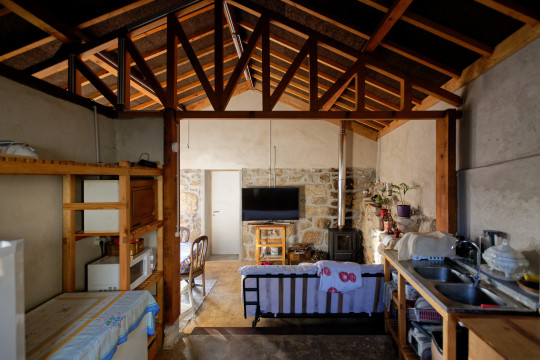
House renovation of a vulnerable family in the context of a social project, co-funded by the Esposende Municipality. | Photo © Critical Concrete
Portugal is one of the countries in Europe that has one of the worst conditions when it comes to housing. If we compare in terms of energy poverty, Bulgaria is the worst in Europe and immediately afterwards comes Portugal. A fact that a lot of Portuguese people lives in poverty with problematic housing conditions gave us this push to start this social architecture initiative instead of project space I was mentioning at the very beginning.
Therefore you initiated the idea of social architecture through the educational format?
SK: Our starting point was organising the summer school project, where we kicked out the project with a direct social impact by a crowdfunding the action through an educational format. So the students would pay for the educational format that would cover most of the cost of refurbishment of the sites and mentors’ work.
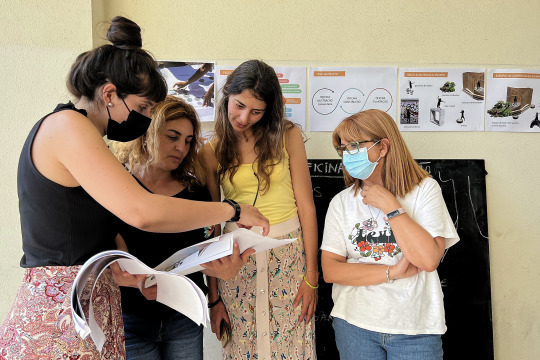
Participatory design of a public space re-qualification in Apúlia, co-funded by the Esposende Municipality. | Photo © Critical Concrete
Critical Concrete is a practice with the focus in solving different housing problems?
SK: We work within the district municipality to find a family unit that would be in a situation of housing distress. We organise three weeks workshop for the complete refurbishment of the house. Our result is a social and sustainable architecture.
Covid pandemic brought solitude and isolation; how did you work during these times?
SK: Before the pandemic we organised four summer schools from 2016 - 2019, which we stop during the pandemic and move to a long term educational program. We set up a plan of post-graduation course, a kind of a master that last for one year. It is a specialisation program that we set up in collaboration with ESAP (Escola Artistica do Porto) and evaluate the degree.
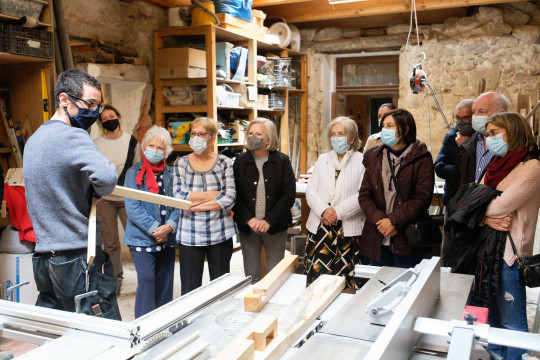
Carpentry workshop with the Inter-generational University of Ramalde. | Photo © Critical Concrete

Participatory design and construction of outdoor furniture for a community space in Ramalde (Porto). | Photo © Critical Concrete
In such way we developed the theoretical experience of summer school and instead of having an intense hands-on practice in only three, we extended it over six weeks. We still have two workshops, just in longer period of time during the whole year. With online classes we still focus on the idea of the execution of one third theoretical and two third of practical program. In such way a new educational system, our learning platform of sustainability is created as an autonomous project Criti.co.
You are also funding self sufficient projects?
SK: The transition of this work become clear during the pandemic. It was very clear the we need to be more robust if we want to survive. We engage a valid group of people to create a social impact and become an advocative for sustainability.
So you create an open source in collaboration with different partners?
SK: Yes, for sure.
When we talk about Critical Concrete, we talk about new construction materials and prototypes?
SK: This is an ongoing research that we are developing. At our own start we realised how ignorant we were when it comes to use of the sustainable materials. That’s why we started to question ourself the possibility of using such materials as mycelium. Our first insulation prototype was very simple and when we started to work with mycelium we realised how fireproof, how resistant to water and how biodegradable is. We are still testing, working on the prototypes so this is still a research phase that needs more time and money to be fully developed and realised.
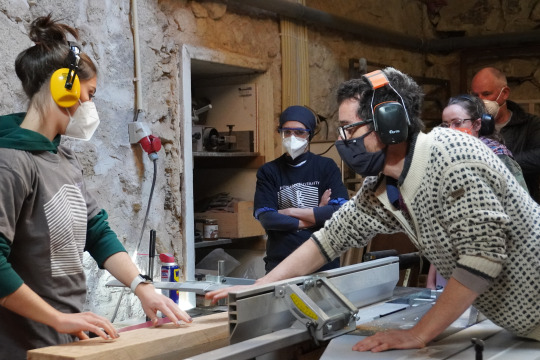

Hands-on workshop with the students of Critical Concrete and ESAP’ Sustainable-Sustainable Architecture post-graduation. | Photo © Critical Concrete
What is the importance of self-build projects?
SK: We are using our project space for prototyping. We test anything we would like to apply to a client’s home. The most emblematic test was the asbestos roof of the workshop, which we remove and built a green semi intensive roof. This was a challenge to work with wooden materials. Part of the green roof lay on the new foundation where we used the structure of old tires. We collaborated with organisation dealing with the insolation panels made of corks. There are many small solutions, which shall be discovered, tested and implemented into new solution for better living conditions.
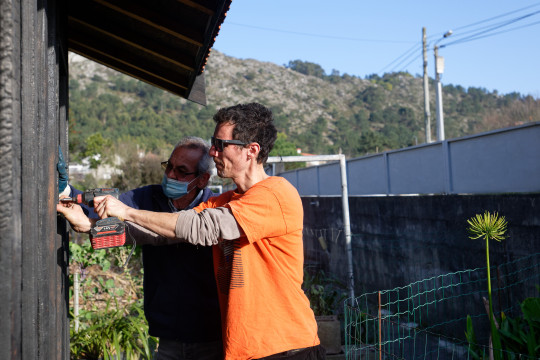
Samuel Kalika is the founder of Critical Concrete. After studying mathematics (BA – Paris VI, 2003) and fine arts (MA – UPV, Valencia & CAFA, Beijing, 2011), Samuel moved to Berlin to coordinate the ZK/U Center for Arts and Urbanistics of Berlin (2011 – 2016). There, he worked mainly around the problematics of sustainability of DIY, placements of artists in non-artistic organisations and coordinated the artistic residency. In parallel, he was developing socially engaged artistic projects 2010. In the continuation of his work at the ZK/U, Samuel founded Critical Concrete in 2015. The intention of the project was to create a socially relevant cultural project, a production centre, platform for makers and locals in a suburb of Porto. Hit by the housing poverty they encountered when scouting for spaces, Samuel and Juliana — first project coordinator — redesigned the project for it to be a solution to tackle this issue, resolve some situation, and sensibilise young people to this hidden reality. On a second stage, the production centre Co-Lateral was opened in September 2016 in the neighbourhood of Francos, in the North West of Porto.
3 notes
·
View notes
Text
Finished reading “O Mistério da Estrada de Sintra”, by Eça de Queirós and Ramalho Ortigão.
This is one of those that has been sitting on the shelf for some ten years now, and I’m happy that I finally made room for it.
It’s fun and cheesy, and notable mostly for:
a) the fact that it was written by two of Portugal’s most well known 19th century authors working together;
b) being Portugal’s first important crime-mystery novel;
and c) the manner in which it was published.
The book consists of a series of anonymous letters by the various characters, written to the editor of a major newspaper, and describing the events of this crime that supposedly took place.
At the time it was actually published in that form, so readers would have been following along in the newspaper week by week as the story unfolded. And, since all characters are all anonymized, the idea is of course that this could very well be a real story taking place in their city right now. It’s that War of the Worlds vibe. This is probably my favorite aspect of the book.
Now the authors themselves years later thought this book rather silly, but nonetheless thought it important to have it published and wrote in the preface of a later edition the following (english google translation below)
O que pensamos hoje do romance que escrevemos há catorze anos?... Pensamos simplesmente – louvores a Deus! – que ele é execrável; e nenhum de nós, quer como romancista, quer como critico, deseja, nem ao seu pior inimigo, um livro igual. Porque nele há um pouco de tudo quanto um romancista lhe não deveria pôr e quase tudo quanto um crítico lhe deveria tirar
Poupemo-lo – para o não agravar fazendo-o em três volumes – à enumeração de todas as suas deformidades? Corramos um véu discreto sobre os seus mascarados de diversas alturas, sobre os seus médicos misteriosos, sobre os seus louros capitães ingleses, sobre as suas condessas fatais, sobre os seus tigres, sobre os seus elefantes, sobre os seus iates em que se arvoram, como pavilhões do ideal, lenços brancos de cambraia e renda, sobre os seus sinistros copos de ópio, sobre os seus cadáveres elegantes, sobre as suas toilettes românticas, sobre os seus cavalos esporeados por cavaleiros de capas alvadias desaparecendo envoltos no pó das fantásticas aventuras pela Porcalhota fora!...
Todas estas coisas, aliás simpáticas, comoventes por vezes sempre sinceras, desgostam todavia velhos escritores, que há muito desviaram os seus olhos das perspectivas enevoadas da sentimentalidade, para estudarem pacientemente e humildemente as claras realidades da sua rua.
Como permitimos pois que se publique um livro que, sendo todo de imaginação, cismado e não observado, desmente toda a campanha que temos feito pela arte de análise e de certeza objectiva?
Consentimo-lo porque entendemos que nenhum trabalhador deve parecer envergonhar-se do seu trabalho.
Conta-se que Murat, sendo rei de Nápoles, mandara pendurar na sala do trono o seu antigo chicote de postilhão, e muitas vezes, apontando para o ceptro, mostrava depois o açoite, gostando de repetir: Comecei por ali. Esta gloriosa história confirma o nosso parecer, sem com isto querermos dizer que ela se aplique às nossas pessoas. Como trono temos ainda a mesma velha cadeira em que escrevíamos há quinze anos; não temos dossel que nos cubra; e as nossas cabeças, que embranquecem não se cingem por enquanto de coroa alguma, nem de louros, nem de Nápoles.
Para nossa modesta satisfação basta-nos não ter cessado de trabalhar um só dia desde aquele em que datámos este livro até o instante em que ele nos reaparece inesperadamente na sua terceira edição, com um petulante aninho de triunfo que, à fé de Deus, não lhe vai mal!
Então, como agora, escrevíamos honestamente, isto é, o melhor que podíamos desse amor da perfeição, que é a honradez dos artistas, veio talvez a simpatia do público ao livro da nossa mocidade.
English google translation
What do we think today of the novel we wrote fourteen years ago?... We simply think – praise to God! – that it is execrable; and none of us, either as a novelist or as a critic, wishes, not even on our worst enemy, an equal book. Because in it there's a little bit of everything a novelist shouldn't put in it and almost everything a critic should take from it.
Shall we spare it – so as not to aggravate it by making it in three volumes – the enumeration of all its deformities? Let us draw a discreet veil over its masked people in different heights, over its mysterious doctors, over its blond English captains, over its fatal countesses, over its tigers, over its elephants, over its yachts on which fly, as pavilions of the ideal, white cambric and lace handkerchiefs, on its sinister glasses of opium, on its elegant corpses, on its romantic toilettes, on its horses spurred by knights in white capes disappearing wrapped in the dust of the fantastic adventures through the Nutty out!...
All these things, moreover pleasant, moving at times always sincere, nevertheless displease old writers, who have long since turned their eyes away from the cloudy prospects of sentimentality, to patiently and humbly study the clear realities of their street.
How do we allow it to be and publish a book that, being all of the imagination, brooded and not observed, refutes the entire campaign we have been doing for the art of analysis and objective certainty?
We allow it because we understand that no worker should appear to be ashamed of their work.
It is said that Murat, being King of Naples, had his old postilion whip hung in the throne room, and often, pointing to the scepter, would then show the whip, enjoying repeating: I started there. This glorious story confirms our opinion, without meaning that it applies to our persons. As a throne we still have the same old chair we used to write on fifteen years ago; we don't have a canopy that covers us; and our heads, which are whitening, do not, for the time being, girded with any crown, neither of laurels nor of Naples.
For our modest satisfaction, it is enough for us not to have stopped working for a single day from the time we dated this book to the moment when it unexpectedly reappears to us in its third edition, with a petulant year of triumph that, to the faith of God, does not not look bad on it!
Then, as now, we were writing honestly , that is, the best we could from that love of perfection, which is the honesty of artists, perhaps the public's sympathy came to the book of our youth.
I copied out the whole thing (and apologise for not taking the time to do a better translation) because this preface might actually be my favorite part of the whole book.
Yes the book is cheesy, and oversentimental and all of the other things its authors accuse it of being. Yet, people loved it, and they chose to let it be republished even though they no longer agreed with most of the things in it. I just find it nice and refreshingly healthy, especially coming from these sources.
Anyhow, it was a fun little read, that is probably more important for its context than its content, but I can certainly recommend it to someone who’s curious about portuguese literature.
#shinylitwick reads books#misterio da estrada de sintra#eça de queirós#ramalho ortigão#long post#apologies for the length
3 notes
·
View notes
Photo

vogue portugal ended the year 2019 in a big way with covers throughout the year that, frankly, were remarkable especially when compared to the covers of the big four (uk, italy, usa, paris).
now, we have this. and here’s vogue’s justification:
Our July/August issue is themed ‘The Madness issue’, with four different covers each designed to address different dimensions of human behaviour, during a time when the global pandemic has brought people to confinement.
One of the covers portrays a hospital scene where the model is being taken care of by her real life mother and grandmother, shot by photographer Branislav Simoncik. Our intention is to open up the topic of mental health, and bring to the discussion the institutions, the science and the people that are involved with mental health today. The cover story explores the historical context of mental health and is designed to reflect real life and authentic stories, inspired by deep research of hundreds of reportage photographs from some of the most relevant and famous documentarists who have captured mental health hospitals. Inside the issue, features interviews and contributions from psychiatrists, sociologists, psychologists and other experts in the field. Mental health forms just one of the topics explored within the issue and is not linked to the theme of madness but instead covered as an aspect of human emotions and behaviour.
which is clearly not just bullshit, but also completely missing the point. i mean, just the fact they claim to wanted to talk about mental illness AND did heavy research and have specialists talking about important mental health issues but still fucking call the issue the "madness" issue kind of says it all.
however, it’s not even the worst thing that happened because people in the industry (or directly related to vogue portugal) have come up publicly defending the cover ... and they aren’t even pretending to take criticism into account:
José Santana defends that there is nothing offensive in the image, he says to the newspaper "Público", and that what you see is the main character to be taken care of by two nurses who, in this case, are the model's mother and grandmother - Simona Kirchnerova - in a mental hospital in Bratislava. In the statement sent to the British newspaper José Santana also adds that the image is a tribute to patients and health professionals. "We also want to bring the institutions, science and areas that deal with mental illness to the debate", adds the same text. The director of the Portuguese edition of the international magazine, Sofia Lucas, on the other hand, reacts defending that “they are judging the book by its cover", she says to “Público”. “This is a rash judgment because the covers are controversial but nobody has read the inside. We deal with important issues ", he adds. José Santana, in the statement, says:" As a creative director, I am concerned about artistic freedom being attacked, because it seems that you cannot talk about anything these days ".
stupidity, ignorance, tone-deaf .... what a bingo we have here huh. it feels relevant to mention that not that long ago, a portuguese actor - who was allegedly going through mental health issues (as well as others) - committed suicide.
so much to touch on and me with my little patience truly just want to smack people in the face because i’m exhausted. i’m just exhausted of the nonsense.
and for those who say that this issue has other covers and that these criticisms seem to be carefully targeted: fuck you. I don’t care that over cover (two that I personally think are very good) exist, there could exist a thousand, i care that THIS one - called the “madness issue” - does and frankly i’m glad vogue portugal is being dragged internationally.
67 notes
·
View notes
Text
PINHAIS: A Testimony of A Living History

(Translated from Maria Martinho's article, edited by S. M. Amamangpang)
A stone's thrown from the sea, Matosinhos is the epicenter of the canning industry to the north of Portugal. In that area alone, 52 fish factories were installed, today only two remain and one of them is PINHAIS. The company was founded in 1920 by António Rodrigues Pinto Pinhal together with his brother Manuel Rodrigues Pinto Pinhal, natives of Espinho, who initially dedicated themselves to salting fish in a small warehouse, and Luíz Alves da Silva Rios, who is believed to have launched the challenge to the two fishing brothers to set up a company dedicated to the manufacture of canned fish, to which Luíz de Sousa Ferreira later joined. With the construction of the factory, the company started to produce canned sardines, mackerel and horse mackerel in olive oil, spicy olive oil, tomato and spicy tomato sauce. “We still maintain the original process. From the treatment of the fish to the packaging, everything is done by hand,” guarantees António Pinhal, grandson of the founder and currently responsible for the family business that is in the third generation.
He was only eight when he had his first memory linked to Pinhais. Hand in hand with his father, he saw trawlers loaded with fish arriving at Matosinhos pier on a Saturday morning. “I always did that at the weekend, it was happy to see the seagulls approaching, it was a sign that there was a lot of fish”, he tells The Observer. Later, he was in his fourth year in Economics at the University of Porto when his father asked him to work with him. “My cousin was his right hand, but he got sick and called me. I went to the auction to buy the fish, did the commercial and export part. Only when my cousin passed away did I join the staffs of the company directly and, as a working student, I finished the Economics course at night. ”

For a decade, António was responsible for carefully choosing the raw materials for preserves, a function that allows him to distinguish the quality of a sardine with the naked eye today. “The sardine caught at four or five in the morning is better than the hake at midnight, I can see that from the eyes, the gills and the scales”, he says, adding that it was also on the wooden base of the trucks used to transport the baskets of fish that could take the real test of the nine. “I would take the sardine and throw it to the wood, if it jumped it had been caught in the morning, if it was quiet it was because it had been caught earlier.”
When he finished his Economics course, he already had several job offers, but his father said: either the bank or the factory. “The bug got into me and I ended up staying here. I don't know if I did it right or wrong, but I don't regret it.”
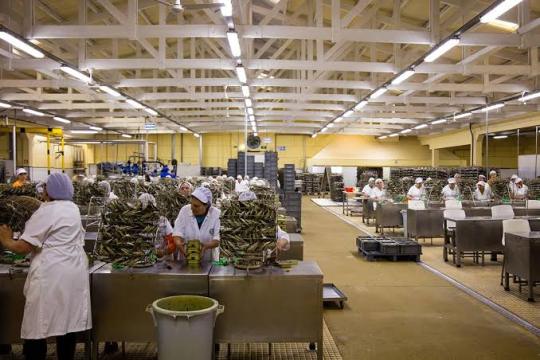
While most canning companies have industrialized over the years, Pinhais has decided to remain faithful to artisanal production, despite the various crises. “There was a Portuguese olive oil supplier that sold the product much cheaper and one day he asked my father if he didn't want to buy a car, which at that time cost about 100 contos, with the money he saved. My father did not have a license nor did he know how to drive, so he refused.” It was like this for four years, until it was discovered that this oil was adulterated. “The containers that other firms distributed to the United States were recalled and the canning industry crisis started there.”
In 1935, Pinhais launched Nuri, a brand with the same products, but aimed at the international market. “One of the partners in the company was my uncle, a public relations person who spoke several languages. It was he who discovered the first international markets and when he went to Spain he met a very beautiful Spaniard named Nuri, that's how he decided to name the brand. ”

During the 40 years that he is at the helm of the canning industry, António Pinhal confesses that the most difficult moment was when the European Union's share of fishing emerged. The golden season in Matosinhos was from June to October, which forced the official to go buy fish in Sines, Peniche, Figueira da Foz, Spain or France. Nothing that would move him or make him lose his faith, after all the Pinhal family is deeply Catholic and in António's office are visible old cans, black and white photographs of the family, but also saints and candles.
“My father went to Mass twice a day and until three years ago we used to pray the rosary half an hour before the people left.” At 4:30 pm, someone put a cassette in the tape recorder and workers exchanged fish scissors for the rosary. “We stopped doing that when we hired people with other religions, it didn't make sense to be imposing that. It used to be different, people were more devout, especially when we talk about a fishing community. Times change and we have to accept those changes. ”

The fish arrives every morning through a special door, leaves the boxes and is immersed in an aluminum container in cold water and salt where the brine is given. “The large sardine is 40 minutes, the medium is 15 minutes, and the petinga, 5,” says António Pinhal. After this process, sardines, mackerel and horse mackerel are spread on large marble tables, where the head and the gut are removed with a small knife. "This is a normally mechanized process, but here we do it by hand to ensure that the gut comes out completely."
Headless and with a spine, the fish is placed one by one on a metal grid and dipped in a tank with cold water to remove the salt. The rooks loaded with fish are distributed in carts that enter a greenhouse at 100 degrees for 10 to 12 minutes. They come out of there hot and during the cooling process all the moisture and grease drain out. “Thus, both water and fat do not go into the can and oil, when added, turns yellow and not brown. This is one of our major differences from the competition,” explains António Pinhal.
It is only after this phase that the fish is placed in containers to then be cut by hand with scissors to fit in the can of preserves, which can then carry tomato sauce, cucumber, carrot or chilli pickles. In this assembly line, several employees dressed in white are seated in a row, from the cap to the wellies, passing through the waterproof apron. Many have their names written on the back and pillows to ensure comfort throughout the day.
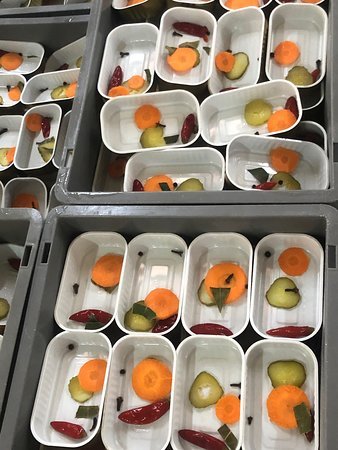
Emília Vaz is in the section dedicated to homemade tomato sauce. She is 67 years old and is the oldest employee of Pinhais. She started at 18 and at the end of 2020, she will retire. With the reddish apron and the sweat on her forehead, she proudly shows the marks on her body that the years of work left him. “I've already cut myself on the toes with the cans and scalded my foot to make tomato sauce,” she says, adding that the factory is her second home and her colleagues are part of her family. She treats them by their first name and says she likes to teach those who arrive there for the first time. Among all, she is known as the “Emília da Afurada” (Emília, The Sharp). “In the past, I crossed the Douro in a small boat, but nowadays I take the bus to Boavista and then take the metro to get here.”
About 30,000 cans come out of Pinhais every day, essentially filled with sardines. There is no waste around here, proof of this is that the fish's head, tail and gut is sent to the flour industry to fertilize the soil and the remaining oil is supplied to the soap industry. On the mechanical mat, the cans stuffed with fish and other ingredients arrive in a veritable rain of Portuguese olive oil and are then closed by another machine. Still greasy, the closed can is washed in a tank with water at 100 degrees and sterilized for 60 minutes to eliminate any bacteria and will be packed by hand. Three months is the minimum time to stay in the warehouse to gain flavor, only after this period of maturation is the canned ready to go on its journey.
Célia Ferreira is responsible for the packaging department and in the 15-minute snack break she is the only one in the room to wrap cans of preserves. “I can eat at home,” she says, smiling, guaranteeing that she likes what she does. Her mother, aunts and cousins passed through Pinhais, so it would be almost inevitable for Célia to also work at the Matosinhos factory, where 1,200 cans per day pass through her hands. The natural employee of Leça da Palmeira walks surrounded by cards and packages painted in yellow, green, red or blue and knows the destination of each one by heart. "These go to Australia, those to the United States and those to the Czech Republic.
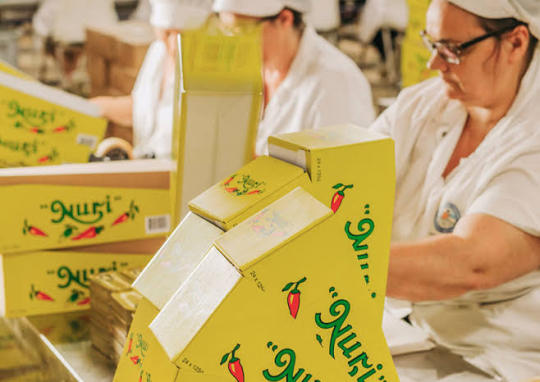
In 2016, the Pinhal family sold its stocks to an Austrian agent, the current owner of the brand. “It was a decision motivated by the fishing crisis, there were no orders, we lacked liquidity and we thought it was necessary to take this step. He is a trustworthy person, he has worked with us since 1985, he belongs to a family business connected to cereals. At one time, he was our best customer, he represented more than 70% of our exports, and he became the only way to save this firm,” recalls António Pinhal. Despite the change, everything seems to have remained. “The only premise was to leave everything as it is.” Currently, Pinhais exports 90% of its production to countries such as Austria, the United States, the Philippines, Denmark or France. Here, the points of sale are limited to gourmet stores. “Quantity is not quality. We bet on quality, while in large stores we buy a can of sardines at 0.90 cents, ours costs € 2.50. The labor is very expensive, we work with 14 or 15 stages, the other factories have only three,” justifies António Pinhal.
Extending the range of products is not part of the brand's plans, which work on original marble tables from 1920 and see their work space limited to small fish. However, there is a need to bring something new to the market, so next year, Pinhais will use leftover sardines to market patês. The online store was launched just in time for the pandemic and in the summer of 2021 a live museum is expected on the factory premises, a project that has lived in the drawer for several years and bureaucracy has delayed. “We want to make it known what the tradition of the canning industry was, showing, at the same time, how we work.”
António Pinhal is not afraid of the future and says that only the pandemic forced small changes in the company, such as the acrylics arranged among the workers, a laboratory converted into a quarantine room and more mechanized transport processes. The grandson of the founder of Pinhais eats preserves religiously every Friday at lunch. “Canning tins are normally six years old as an expiration date, but my father always preferred old ones that were 15 or 20 years old. Every Friday at lunch he opens an old can, watched, smelled and asked me to eat a piece. After five minutes, if I didn't feel bad, I would eat it. It was your guinea pig and I thought it was funny. ”
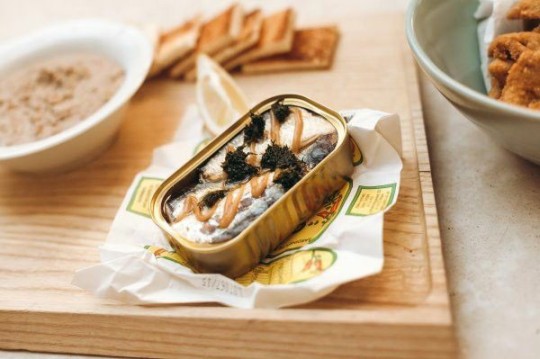
Source:
(https://observador.pt/2020/09/13/conservas-pinhais-a-fabrica-onde-se-rezava-o-terco-e-hoje-se-canta-o-fado-enquanto-se-enchem-latas/)
#Pinhais#Matosinhos#Portugal#sardines#sardinha#sardinas#sardinia#Nuri Sardines#Mabuti Sardines#Rios Sardines#artisanal#traditional
8 notes
·
View notes
Text
Long, unedited text in which I rant about comparative mythology, Joseph Campbell and his monomyth,
Back in 2012 I wanted to improve my fiction writing (and writing in general, because in spite of nuances, themes and audience, writing a fiction and a nonfiction piece shouldn’t be that different) and thus I picked a few writing manuals. Many of them cited the Hero’s Journey, and how important it became for writers – after all Star Wars used and it worked. I believe most of the people reading this like Star Wars, or at least has neutral feelings about it, but one thing that cannot be denied is that became a juggernaut of popular culture.
So I bought a copy of the Portuguese translation of The Hero of a Thousand Faces and I fell in love with the style. Campbell had a great way with words and the translation was top notch. For those unaware, The Hero of a Thousand Faces proposes that there is a universal pattern in humanity’s mythologies that involves a person (usually a man) that went out into a journey far away from his home, faced many obstacles, both external and internal, and returned triumphant with a prize, the Grail or the Elixir of Life, back to his home. Campbell’s strength is that he managed to systematize so many different sources into a single cohesive narrative.
At the time I was impressed and decided to study more and write in an interdisciplinary research with economics – by writing an article on how the entrepreneur replaces the mythical hero in today’s capitalism. I had to stop the project in order to focus on more urgent matters (my thesis), but now that I finished I can finally return to this pet project of mine.
If you might have seen previous posts, I ended up having a dismal view of economics. It’s a morally and spiritually failed “science” (I have in my drafts a post on arts and I’m going to rant another day about it). Reading all these books on comparative mythology is so fun because it allows me for a moment to forget I have a degree in economics.
Until I started to realize there was something wrong.
My research had indicated that Campbell and others (such as Mircea Eliade and Carl Gust Jung, who had been on of Campbell’s main influences) weren’t very well respected in academia. At first I thought “fine”, because I’m used to interact with economists who can be considered “heterodox” and I have academic literature that I could use to make my point, besides the fact my colleagues were interested in what I was doing.
The problem is that this massive narrative of the Hero’s Journey/monomyth is an attempt to generalize pretty wide categories, like mythology, into one single model of explanation, it worked because it became a prescription, giving the writer a tool to create a story in a factory-like pace. It has checkboxes that can be filled, professional writers have made it widely available.
But I started to realize his entire understanding of mythology is problematic. First the basics: Campbell ignores when myths don’t fit his scheme. This is fruit of his Jungian influences, who claim that humanity has a collective unconsciousness, that manifest through masks and archetypes. This is the essence of the Persona games (and to a smaller extent of the Fate games) – “I am the Shadow the true self”. So any deviation from the monomyth can be justified by being a faulty translation of the collective unconsciousness.
This is the kind of thing that Karl Popper warned about, when he proposed the “falseability” hypothesis, to demarcate scientific knowledge. The collective unconsciousness isn’t a scientific proposition because it can be falsified. It cannot be observed and it cannot be refuted, because someone who subscribe to this doctrine will always have an explanation to explain why it wasn’t observed. In spite of falseability isn’t favored by philosophers of science anymore, it remains an important piece of the history of philosophy and he aimed his attack on psychoanalysis of Freud and Jung – and, while they helped psychology in the beginning, they’re like what Pythagoras is to math. They were both surpassed by modern science and they are studied more as pieces of history than serious theorists.
But this isn’t the worst. All the three main authors on myths were quite conservatives in the sense of almost being fascists – sometimes dropping the ‘almost’. Some members of the alt-right even look up to them as some sort of “academic’ justification. Not to mention anti-Semitic. Jung had disagreement with Freud and Freud noticed his anti-Semitism. Eliade was a proud supporter of the Iron Guard, a Romanian fascist organization that organized pogroms and wanted to topple the Romanian government. Later Eliade became an ambassador at Salazar’s Fascist Portugal, writing it was a government guided by the love of God. Campbell, with his hero worship, was dangerously close to the ur-fascism described by Umberto Eco (please read here, you won’t regret https://www.pegc.us/archive/Articles/eco_ur-fascism.pdf).
“If you browse in the shelves that, in American bookstores, are labeled as New Age, you can find there even Saint Augustine who, as far as I know, was not a fascist. But combining Saint Augustine and Stonehenge – that is a symptom of Ur-Fascism.”
Campbell did that a lot. He considered the Bible gospels and Gnostic gospels to be on the same level. Any serious student, that is not operating under New Age beliefs and other frivolous theories like the one that says Jesus went to India, will know there’s a difference between them (even Eliade was sure to stress the difference).
But Campbell cared nothing for it. He disliked the “semitic” religions for corrupting the mythic imagination (which is the source of his anti-Semitism), especially Judaism. When I showed him describing the Japanese tea ceremony to a friend who’s minoring in Japanese studies, she wrote “I’m impressed, he’s somehow managed to out-purple prose the original Japanese”. So, it’s also full of orientalism, treating the East as the mystical Other, something for “daring” Westerners to discover and distillate.
What disturbed…no, “disturbed” isn’t the word that I need in the moment, but what made me feel uncomfortable is that, in spite of all his talk of spirituality, the impression I had of Power of Myth is that I don’t think I’ve ever seen anyone more materialist than him. Not even Karl Marx, founder of the Historical Materialism, was as materialist as Campbell.
At one point in the book, he was asked if he believed in anything and he gave a dismissive reply and said “I want to get experiences.” A man who studied all the myths of the world available, apparently didn’t believe in anything. Is that what spiritual maturity is? A continuous flux of experiences? Being taken by some sort of shamanistic wind like a floating plastic bag?
In nowhere in the interview he talked about virtues. In rebellion with his Catholic childhood, he said that we should go to the confessionary and say “God, I’ve been such a good boy”. Any cursory reading of the Gospel would say otherwise. Wasn’t this exactly Pharisee’s prayer in Luke 18:9-14? While the wasn’t the publican, who went with humility and asked for forgiveness, the one who walked out with an experience? And not only in Christianity, since in Tibetan Buddhism, a tulpa is something you have to kill, not foster like an imaginary friend like in some internet circles, contamined with this obsession with experiences.
The way I came to see Joseph Campbell as a man who was so stuck in his own world that nothing could move him out of it. All he wanted to do was this big experience, but in the end it’s as wide as the ocean, but shallow as a puddle. Even when Campbell speaks about having a “cosmic consciousness”, all that New Age jargon, claiming it’s about people discovering they’re not the center of the universe, it’s still so…self-servicing. It addresses a crowd so obsessed with experiences, but wants nothing to do with anything that requires compromise. He quotes the Hindu concept of maya, that life is an illusion, but I wonder how right he is about it.
I want to share this critique, by a researcher in comic studies: “We do not remember The Night Gwen Stacy Died because Gwen’s death reminds us of our own mortality, ‘the destiny of Everyman’, but because the story exposes the fragility of Spider-Man reader’s fantasies. Even icons can die.”
The exposition of the fragility of myths, especially the Hero’s Journey, never happens in Campbell’s work. It never talks about the potential of myths hindering entire societies, causing strife and causing people who can’t fit to become outcasts. Not even the cruel ones, like the Aztec death cult is treated as sublime, ignoring the fact that the Aztec neighbors helped to Spanish because they had enough of the Aztec myth.
I have changed my article. While I will still write on the hero entrepreneur, I’ll take a more critical view. The focus of the entrepreneur as an individual has many issues, because it ignores the role of public investment (necessary for high risk enterprises, like going to the moon or creating touch screens) and it treats with contempt the worked wage. Cambpell also treated with contempt the “masses”, who cannot be “heroes”. The theory on the entrepreneur is the same, treating the entrepreneur as a hero and the waged workers as lowlifes who have nothing to do, but to work, obey and be paid – to the point it feels like some economists treat strikes as crimes worse than murder. Not only that, but they can exploit the worker (see a book named “Do what you love and other lies about success and happiness”, it could be replaced with “Follow your bliss…”).
Campbell wrote in a time that there was no Wikipedia. So his book was the introduction of myths to a lot of people. It helped it was well-written. He considering his approach apolitical, but it’s clear that’s it’s not exactly like that (though this is a reason why Jordan Peterson failed to become the next Campbell, since he’s also a Jungian scholar, but he tried to become a conservative guru and this was his downfall). And, nowadays, Campbell is still inevitable in the circles that his themes matter, unlike Freud and Jung. Read it, but be aware of its problems, because it has already influenced what you consume.
10 notes
·
View notes
Note
how about 11, 15, 20 for the “not from the US” asks!💖 -🥨
11 - favourite native writer/poet?
omg yes i was hoping someone would ask this!! i absolutely LOVE portuguese literature and especially our poets. my favourite would be Antero de Quental, and his works are from the late 19th century (1860s-1890s). He wrote about slightly darker topics, the constant search for happiness and how he believed that search to be fake and how he felt he could never achieve it. He talked about the nights and faith, and he feared death itself. Ironically enough, [trigger warning: s*icide] for someone who feared death he ended up killing himself out of his own pain and suffering for what would come next. His poetry is truly amazing,
[safe now!]
I will link some of my favourite works here (in english) if anyone’s interested:
the palace of happiness
night
another poet i really really like is Fernando Pessoa. This is a very interesting poet because he created a LOT of different heteronyms whom he would write under. It is believed he had over 100. The thing that makes it interesting is he would make zodiac charts, careers, backstories and personalities for his heteronyms and would write according to that. His work, as Fernando Pessoa, was about his worries, how much he wanted to achieve a dream land and how he knew it didn’t exist. He had this idea that you’re only ever truly happy when you’re unaware of your happiness, and that is not achievable to you because that’s mostly in your childhood. He wanted to be subconsciously happy, like he was in his childhood, but to be conscious that he was subconsciously happy, so he could enjoy it unlike his childhood that just slipped from his fingers. It’s obviously a paradox.
Out of all his heteronyms, a few stayed as the most important. Alberto Caeiro, who wrote simple words about he world around him, because he was a man from the rural areas of Portugal and did not care for big words or philosophies. His poetry was about nature and wanting to be one with nature. ; Ricardo Reis, a doctor, who spoke in sophisticated words and talked about living life in the present. Ricardo Reis denied attachment and denied the idea of doing anything for your life, instead letting it flow like a river going towards the sea. The least attachments you have, the least you and others will suffer once you’re gone. ; Álvaro de Campos, who was the most like Fernando Pessoa himself in the sense that he talked a lot about the anguish in his childhood, but also about the new times and the revolution of machines, the noise of the growing cities and the problems with our dictatorship.
again, I will leave some of my favourite works here if anyone’s interested. unfortunately, they are in portuguese so if you want them translated you can ask me or go on google translate:
‘sou um guardador de rebanhos’, alberto de caeiro (nature focus)
‘lisbon revisited’, álvaro de campos (despite the title, it’s in portuguese. it’s focused on being alone being better than having bad companies, and the frustrations of society values)
‘autopsicografia’, fernando pessoa (how a poet is fake, because they write about the things they felt and not what they are currently feeling)
‘i am the escaped one’, fernando pessoa (this one is in english if you wanna check it out!)
‘vem sentar-te comigo Lídia, à beira do rio‘, ricardo reis (about sitting together by the river, watching your life go by and not getting attached to each other.)
‘ouvi contar que outrora, quando a Pérsia‘, ricardo reis (two men who ignore the world in persia and instead keep playing their chess game, because they just want to live until they die and don’t worry about avoiding their destiny)
15 - answered here lovely~
20 - which sport is The Sport in your country?
soccer. cristiano ronaldo. you know the deal
i get really hyped during soccer games you will catch me YELLING and i’m not even the worst in my family. one of the games i will always remember was portugal x france in the finals and the 90 minute game went on for 120+3 MINUTES BECAUSE NOBODY WOULD SCORE IT WAS SO FUCKING STRESSFUL but then we won the world championship lol fuck that was so TENSE
game here! and i am very sorry this got so long :< i got super excited to talk about poetry. i had another poet + another writer i wanted to add but i didn’t wanna overwhelm you guys. WHOEVER WANTS TO TALK ABT LITERATURE PLS PLS PLS COME TO MY DMS
12 notes
·
View notes
Text

46 years ago today, Portugal finally became free from the dictatorship of the New State.
Because of this date, this revolution and the struggle and strength of the people that came before me, I've always felt very connected with this ideal of justice and fighting for the people against an oppressing and corrupt rule.
Maybe that's why I relate with LCDP/the Dalís so much. ♥
This year's celebration is bound to be a little bit different with the pandemic we're living, but we will still celebrate our freedom at home. We will never forget what those who came before did for us and we will always honor them.
Next season, maybe they could introduce Grândola Vila Morena - one of the song that was used on the radio as a signal for the troops (and the people) to move into action that historic day and a symbol of our resistance and freedom ever since. It’s like our version of Bella Ciao.
youtube
It's always intrigued me how the color of the resistance in the show is red - the Profesor's car, his origami, the Dalís’ jumpsuits, the phone in Part 1/2, etc...
The flower of the Portuguese revolution of 1974 was the red carnation, which has lead us to celebrate always with a red carnation and/or simply wearing the color red.

I've always wondered if the two are connected? Especially since Spain and Portugal are neighbouring countries and practically siblings (por cierto, un gran beso para nuestros hermanos♥).
25 DE ABRIL SEMPRE! FASCIMO NUNCA MAIS!! 🇵🇹
22 notes
·
View notes